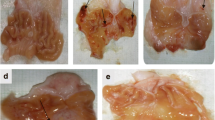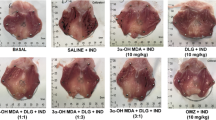Abstract
The concept that gastroprotection by agents such as mild irritants, antacids, or sucralfate is prostaglandin (PG)-mediated has been challenged recently. These agents do not reproducibly stimulate prostaglandin formation, and indomethacin does not effectively attenuate their protective potency. Rebamipide is a novel antiulcer compound. This study was designed to clarify whether eicosanoids contribute to the gastroprotective activity of the drug. In the rat stomach, rebamipide (100 and 500 mg/kg, intraperitoneally) slightly increased release of PGE2, 6-keto-PGF1 α thromboxane B2, and the metabolite 15-keto-13,14-dihydro-PGE2 from mucosal fragments incubated ex vivo and significantly enhanced secretion of these products into the lumen, resulting in gastric juice eicosanoid levels exceeding those in controls several-fold. Mucosal formation of leukotriene (LT) C4 was not affected by rebamipide. Rebamipide caused substantial protection against gastric damage produced by ethanol, which was antagonized by pretreatment with indomethacin (0.1–5 mg/kg, subcutaneously). The dose-response relationship of indomethacin for inhibition of prostaglandin formation and rebamipide-induced protection correlated well and 5 mg/kg indomethacin completely prevented the protective effect of rebamipide. The results indicate that: (1) in contrast to most other protective agents, protection by rebamipide involves the endogenous prostaglandin system; (2) the increase in prostaglandin formation results from stimulation of biosynthesis, and not inhibition of degradation; (3) gastroprotection by rebamipide occurs despite increased thromboxane formation and is not associated with reduced generation of LTC4; and (4) determinations of gastric juice eicosanoids seem to be particularly useful to evaluate effects of agents increasing formation of cyclooxygenase products in the stomach.
Similar content being viewed by others
References
Robert A, Nezamis JE, Lancaster C, Hanchar A: Cytoprotection by prostaglandins in rats. Prevention of gastric necrosis produced by alcohol, HCl, NaOH, hypertonic NaCl, and thermal injury. Gastroenterology 77:433–443, 1979
Robert A, Nezamis JE, Lancaster C, Davis JP, Field SO, Hanchar AJ: Mild irritants prevent gastric necrosis through “adaptive gastroprotection” mediated by prostaglandins. Am J Physiol 245:G113-G121, 1983
Änggård E: The biological activities of three metabolites of prostaglandin E1. Acta Physiol Scand 66:509–510, 1966
Peskar BM, Holland A, Peskar BA: Effect of carbenoxolone on prostaglandin synthesis and degradation. J Pharm Pharmacol 28:146–148, 1976
Uchida M, Tabusa F, Komatsu M, Morita S, Kanbe T, Nakagawa K: Studies on 2(1H)-quinolinone derivatives as gastric antiulcer active agents. Synthesis and antiulcer activity of the metabolites of 2-(4-chlorobenzoylamino)-3-2(1H)-quinolinon-4-yl]propionic acid. Chem Pharm Bull 34:4821–4824, 1986
Yamasaki K, Ishiyama H, Imaizumi T, Kanbe T, Yabuuchi Y: Effect of OPC-12759, a novel antiulcer agent, on chronic and acute experimental gastric ulcer, and gastric secretion in rats. Jpn J Pharmacol 49:441–448, 1989
Yamasaki K, Kanbe T, Chijiwa T, Ishiyama H, Morita S: Gastric mucosal protection by OPC-12759, a novel antiulcer compound, in the rat. Eur J Pharmacol 142:23–29, 1987
Peskar BM, Lange K, Hoppe U, Peskar BA: Ethanol stimulates formation of leukotriene C4 in rat gastric mucosa. Prostaglandins 31:283–293, 1986
Peskar BM, Hoppe U, Lange K, Peskar BA: Effects of non-steroidal anti-inflammatory drugs on rat gastric mucosal leukotriene C4 and prostanoid release: Relation to ethanolinduced injury. Br J Pharmacol 93:937–943, 1988
Jobke A, Peskar BA, Peskar BM: On the specifity of antisera against prostaglandins E2 and A2. FEBS Lett 37:192–196, 1973
Peskar BA, Anhut H, Kröner EE, Peskar BM: Development, specifity and some applications of radioimmunoassays for prostaglandins and related compounds.In Advances in Pharmacology and Therapeutics 2 Biochemical Pharmacology. JP Tillement (ed). Oxford, Pergamon Press, 1978, pp 275–286
Anhut H, Bernauer W, Peskar BA: Radioimmunological determination of thromboxane release in cardiac anaphylaxis. Eur J Pharmacol 44:85–88, 1977
Fitzpatrick FA, Aguirre R, Pike JE, Lincoln FH: The stability of 13,14-dihydro-15 keto-PGE2. Prostaglandins 19:917–932, 1980
Peskar BM, Günter B, Steffens CH, Kröner EE, Peskar BA: Antibodies against dehydration products of 15-keto-13,14-dihydro-prostaglandin E2. FEBS Lett 115:123–126, 1980
Peskar BM, Seyberth HW, Peskar BA: Synthesis and metabolism of endogenous prostaglandins by human gastric mucosa. Adv Prostaglandin Thromboxane Res 8:1511–1514, 1980
Kawano S, Sato N, Kamada T, Yamasaki K, Imaizumi T, Komemushi S: Protective effect of rebamipide (OPC-12759) on the gastric mucosa in rats and humans. Nippon Yakurigaku Zasshi 97:371–380, 1991
Wan BYC, Gottfried S: Cytoprotective action of carbenoxolone sodium on ethanol-induced gastric lesions in rats and its inhibition by indomethacin. J Pharm Pharmacol 37:739–741, 1985
Bennett A, Melhuish PB, Stamford IF: Carbenoxolone and deglycyrrhized liquorice have little or no effect on prostanoid synthesis by rat gastric mucosaex vivo. Br J Pharmacol 86:693–695, 1985
Rask-Madsen J, Bukhave K, Madsen PER, Bekker C: Effect of carbenoxolone on gastric prostaglandin E2 levels in patients with peptic ulcer disease following vagal and pentagastrin stimulation. Eur J Clin Invest 13:351–356, 1983
Esplugues JV, Whittle BJR: Gastric mucosal damage induced by local intraarterial administration of a thromboxane mimetic and PAF in the rat. Gastroenterology 92:1385, 1987
Whittle BJR, Kauffman GL, Moncada S: Vasoconstriction with thromboxane A2 induces ulceration of the gastric mucosa. Nature 292:472–474, 1981
Pihan G, Rogers C, Szabo S: Vascular injury in acute gastric mucosal damage. Mediatory role of leukotrienes. Dig Dis Sci 33:625–632, 1988
Konturek SJ, Brzozowski T, Drozdowicz D, Beck G: Role of leukotrienes in acute gastric lesions induced by ethanol, taurocholate, aspirin, platelet activating factor and stress in rats. Dig Dis Sci 33:806–813, 1988
Peskar BM: Role of leukotriene C4 in mucosal damage caused by necrotizing agents and indomethacin in the rat stomach. Gastroenterology 100:619–626, 1991
Trautmann M, Peskar BM, Peskar BA: Aspirin-like drugs, ethanol-induced rat gastric injury and mucosal eicosanoid release. Eur J Pharmacol 210:53–58, 1991
Derelanko MJ, Long JF: Carbenoxolone sodium protects rat gastric mucosa against ethanol-induced necrosis. Proc Soc Exp Biol Med 166:394–397, 1981
Doll R, Hill ID, Hutton C, Underwood DJ: Clinical trial of a triterpenoid liquorice compound in gastric and duodenal ulcer. Lancet 2:793–796, 1962
Peskar BM: Effects of carbenoxolone on the gastric mucosal prostaglandin and thromboxane system. Acta Gastro-enterol Belg 46:429–436, 1983
Peskar BM: On the synthesis of prostaglandins by human gastric mucosa and its modification by drugs. Biochim Biophys Acta 487:307–314, 1977
Peskar BM, Weiler H: Carbenoxolone inhibits thromboxane B2 synthesis by human gastric mucosa. Gut 24:A480, 1983
Szelenyi I, Postius S, Engler H: Evidence for a functional cytoprotective effect produced by antacids in the rat stomach. Eur J Pharmacol 88:403–406, 1983
Konturek SJ, Kwiecien N, Obtulowicz W, Hebzda Z, Oleksy J: Effects of prostective drugs on gastric alkaline secretion in man. Scand J Gastroenterol 22:1059–1063, 1987
Berstad K, Vergin H, Postius S, Weberg R, Szelenyi I, Berstad A: Gastric prostaglandin E2 release induced by aluminium hydroxide and aluminium hydroxide-containing antacids in rats. Effect of low doses and citric acid. Scand J Gastroenterol 22:884–888, 1987
Preclik G, Stange EF, Gerber K, Fetzer G, Horn H, Ditschuneit H: Stimulation of mucosal prostaglandin synthesis in human stomach and duodenum by antacid treatment. Gut 30:148–151, 1989
Hollander D, Tarnawski A, Gergely H, Zipser RD: Sucralfate protection of the gastric mucosa against ethanol-induced injury: A prostaglandin-mediated process? Scand J Gastroenterol 19 (suppl 101):97–102, 1984
Cohen MM, Bowdler R, Gervais P, Morris GP, Wang HR: Sucralfate protection of human gastric mucosa against acute ethanol injury. Gastroenterology 96:292–298, 1989
Konturek SJ, Kwiecien N, Obtulowicz W, Kopp B, Oleksy J: Double blind controlled study on the effect of sucralfate on gastric prostaglandin formation and microbleeding in normal and aspirin treated man. Gut 27:1450–1456, 1986
Konturek SJ, Radecki T, Piastucki I, Brzozowski T, Drozdowicz D: Gastrocytoprotection by colloidal bismuth subcitrate (De-Nol) and sucralfate. Role of endogenous prostaglandins. Gut 28:201–205, 1987
Malandrino S, Bestetti A, Fumagalli G, Borsa M, Vigano T, Tonon G: Role of endogenous prostaglandins in protection of rat gastric mucosa by tripotassium dicitrate bismuthate. Scand J Gastroenterol 22:943–948, 1987
Wallace JL: Increased resistance of the rat gastric mucosa to hemorrhagic damage after exposure to an irritant. Role of the “mucoid cap” and prostaglandin synthesis. Gastroenterology 94:22–32, 1988
Hawkey CJ, Kemp RT, Walt RP, Bhaskar NK, Davies J, Filipowicz B: Evidence that adaptive cytoprotection in rats is not mediated by prostaglandins. Gastroenterology 94:948–954, 1988
Konturek SJ, Brzozowski T, Drozdowicz D, Nauert C: Gastroprotection by an aluminium-and magnesium hydroxidecontaining antacid in rats. Scand J Gastroenterol 24:1113–1120, 1989
Shea-Donohue T, Steel L, Montcalm E, Dubois A: Gastric protection by sucralfate. Role of mucus and prostaglandins. Gastroenterology 91:660–666, 1986
Weberg R, Berstad K, Berstad A: Acute effects of antacids on gastric juice components in duodenal ulcer patients. Eur J Clin Invest 20:511–515, 1990
Trautmann M, Peskar BM: Gastroprotection in rats by the antacids hydrotalcit and maalox does not involve the endogenous prostaglandin and leukotriene system. Gastroenterology 98:A139, 1990
Lambrecht N, Traudmann M, Korolkiewicz R, Liszkay, Peskar BM: Role of eicosanoids, nitric oxide, and afferent neurons in antacid induced protection in the rat stomach. Gut 34, 1993 (in press)
Wallace JL, Morris GP, Beck PL, Williamson TE, Gingras GR: Effects of sucralfate on gastric prostaglandin and leukotriene synthesis: Relationship to protective actions. Can J Physiol Pharmacol 66:666–670, 1988
Author information
Authors and Affiliations
Rights and permissions
About this article
Cite this article
Kleine, A., Kluge, S. & Peskar, B.M. Stimulation of prostaglandin biosynthesis mediates gastroprotective effect of rebamipide in rats. Digest Dis Sci 38, 1441–1449 (1993). https://doi.org/10.1007/BF01308601
Received:
Revised:
Accepted:
Issue Date:
DOI: https://doi.org/10.1007/BF01308601




